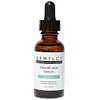What's inside
What's inside
 Key Ingredients
Key Ingredients

 Benefits
Benefits

 Concerns
Concerns

No concerns
 Ingredients Side-by-side
Ingredients Side-by-side

Water
Skin ConditioningGlycerin
HumectantNiacinamide
SmoothingSodium Chondroitin Sulfate
Skin ConditioningMethylglucoside Phosphate
Skin ConditioningCopper Lysinate/Prolinate
Skin ConditioningGlycosaminoglycans
EmollientBambusa Vulgaris Leaf/Stem Extract
HumectantPisum Sativum Extract
Skin ConditioningGlucosamine Hcl
Sodium Hyaluronate
HumectantPanthenol
Skin ConditioningPhenoxyethanol
PreservativeEthylhexylglycerin
Skin ConditioningPolysorbate 20
EmulsifyingDisodium EDTA
Water, Glycerin, Niacinamide, Sodium Chondroitin Sulfate, Methylglucoside Phosphate, Copper Lysinate/Prolinate, Glycosaminoglycans, Bambusa Vulgaris Leaf/Stem Extract, Pisum Sativum Extract, Glucosamine Hcl, Sodium Hyaluronate, Panthenol, Phenoxyethanol, Ethylhexylglycerin, Polysorbate 20, Disodium EDTA
Water
Skin ConditioningLactic Acid
BufferingNeopentyl Glycol Dicaprylate/Dicaprate
EmollientGlycerin
HumectantCaprylic/Capric Triglyceride
MaskingHydrogenated Soybean Oil
EmollientPyrus Malus Fruit Extract
Skin ConditioningSodium Hydroxide
BufferingBeheneth-5
EmulsifyingPolyglyceryl-3 Stearate
EmulsifyingCitrus Grandis Peel Oil
MaskingSodium Acrylates Copolymer
Phenoxyethanol
PreservativeSclerotium Gum
Emulsion StabilisingHydrogenated Polyisobutene
EmollientGluconolactone
Skin ConditioningMandelic Acid
AntimicrobialBisabolol
MaskingTocopheryl Acetate
AntioxidantHydrogenated Soy Polyglycerides
Skin ConditioningHelianthus Annuus Seed Oil
EmollientPhospholipids
Skin ConditioningPolyglyceryl-10 Stearate
Skin ConditioningOpuntia Ficus-Indica Extract
Skin ConditioningAllantoin
Skin ConditioningGlycyrrhiza Glabra Root Extract
BleachingEthylhexylglycerin
Skin ConditioningLactobionic Acid
BufferingSodium Hyaluronate Crosspolymer
HumectantDisodium EDTA
Saccharomyces Cerevisiae Extract
Skin ConditioningDipotassium Glycyrrhizate
HumectantC15-23 Alkane
SolventWater, Lactic Acid, Neopentyl Glycol Dicaprylate/Dicaprate, Glycerin, Caprylic/Capric Triglyceride, Hydrogenated Soybean Oil, Pyrus Malus Fruit Extract, Sodium Hydroxide, Beheneth-5, Polyglyceryl-3 Stearate, Citrus Grandis Peel Oil, Sodium Acrylates Copolymer, Phenoxyethanol, Sclerotium Gum, Hydrogenated Polyisobutene, Gluconolactone, Mandelic Acid, Bisabolol, Tocopheryl Acetate, Hydrogenated Soy Polyglycerides, Helianthus Annuus Seed Oil, Phospholipids, Polyglyceryl-10 Stearate, Opuntia Ficus-Indica Extract, Allantoin, Glycyrrhiza Glabra Root Extract, Ethylhexylglycerin, Lactobionic Acid, Sodium Hyaluronate Crosspolymer, Disodium EDTA, Saccharomyces Cerevisiae Extract, Dipotassium Glycyrrhizate, C15-23 Alkane
 Reviews
Reviews

Ingredients Explained
These ingredients are found in both products.
Ingredients higher up in an ingredient list are typically present in a larger amount.
Disodium EDTA plays a role in making products more stable by aiding other preservatives.
It is a chelating agent, meaning it neutralizes metal ions that may be found in a product.
Disodium EDTA is a salt of edetic acid and is found to be safe in cosmetic ingredients.
Learn more about Disodium EDTAEthylhexylglycerin (we can't pronounce this either) is commonly used as a preservative and skin softener. It is derived from glyceryl.
You might see Ethylhexylglycerin often paired with other preservatives such as phenoxyethanol. Ethylhexylglycerin has been found to increase the effectiveness of these other preservatives.
Glycerin is already naturally found in your skin. It helps moisturize and protect your skin.
A study from 2016 found glycerin to be more effective as a humectant than AHAs and hyaluronic acid.
As a humectant, it helps the skin stay hydrated by pulling moisture to your skin. The low molecular weight of glycerin allows it to pull moisture into the deeper layers of your skin.
Hydrated skin improves your skin barrier; Your skin barrier helps protect against irritants and bacteria.
Glycerin has also been found to have antimicrobial and antiviral properties. Due to these properties, glycerin is often used in wound and burn treatments.
In cosmetics, glycerin is usually derived from plants such as soybean or palm. However, it can also be sourced from animals, such as tallow or animal fat.
This ingredient is organic, colorless, odorless, and non-toxic.
Glycerin is the name for this ingredient in American English. British English uses Glycerol/Glycerine.
Learn more about GlycerinPhenoxyethanol is a preservative that has germicide, antimicrobial, and aromatic properties. Studies show that phenoxyethanol can prevent microbial growth. By itself, it has a scent that is similar to that of a rose.
It's often used in formulations along with Caprylyl Glycol to preserve the shelf life of products.
Water. It's the most common cosmetic ingredient of all. You'll usually see it at the top of ingredient lists, meaning that it makes up the largest part of the product.
So why is it so popular? Water most often acts as a solvent - this means that it helps dissolve other ingredients into the formulation.
You'll also recognize water as that liquid we all need to stay alive. If you see this, drink a glass of water. Stay hydrated!
Learn more about Water